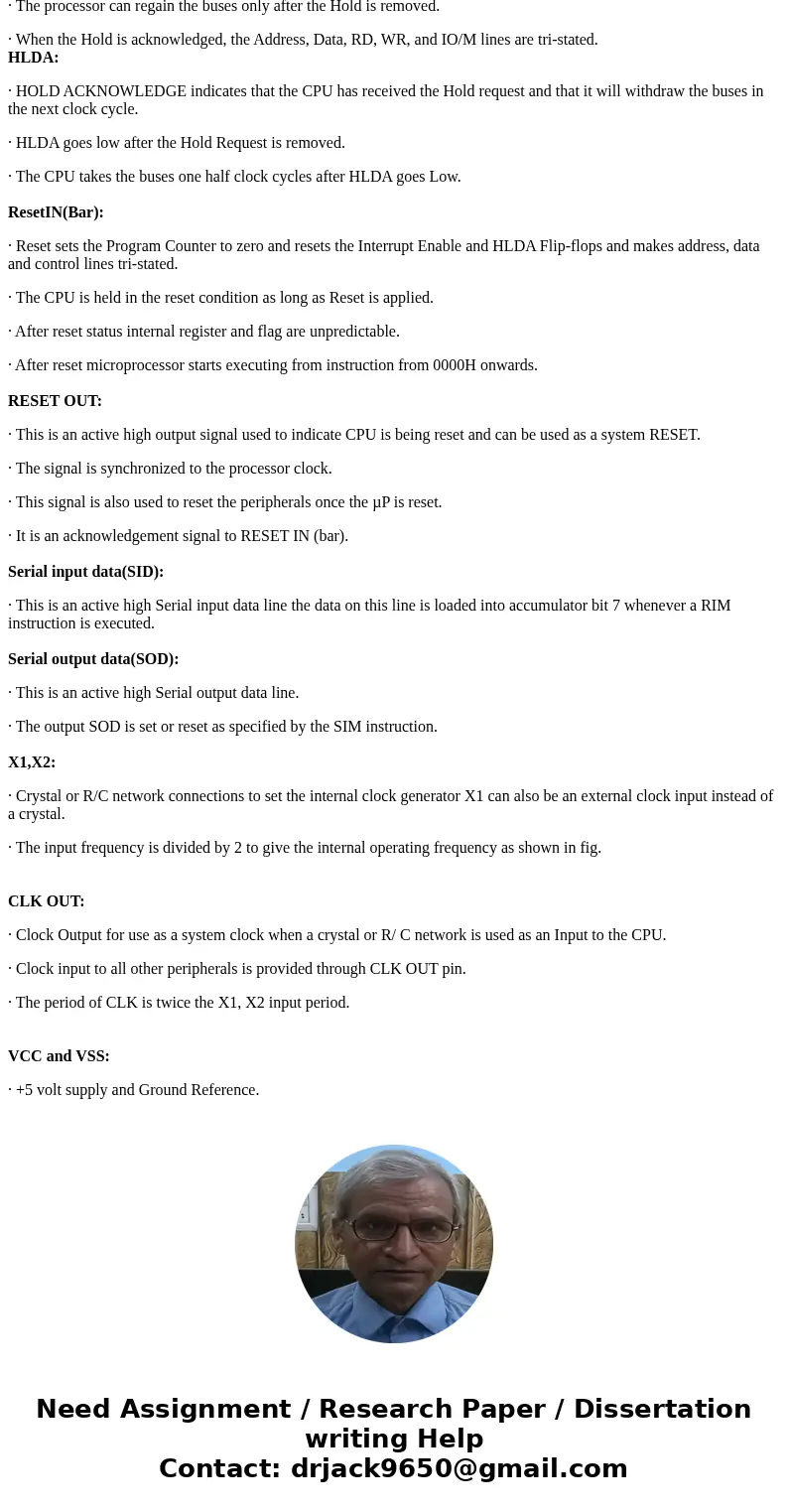microprocessor Design a microprocessor base monitoring syste
microprocessor
Solution
The below Diagram shows the Pin details of 8085:
Functions of various Pins of 8085
A8-A15 Higher Order Address bus:
· These are o/p tri-state (a state of high impedance) signals used as higher order 8 bits of 16 bit address.
· These signals are unidirectional and are given from 8085 to select memory or I/O devices.
AD0-AD7 Multiplexed Address/Data bus:
· These are I/O tri-state signals, having 2 sets of signals. They are address and data.
· The lower 8 bit of 16 bit address is multiplexed/time shared with data bus.
Address latch Enable(ALE):
· It is an output signal used to give information of AD0-AD7 contents.
· It is a positive going pulse generated when a new operation is started by microprocessor.
· When pulse goes high it indicates that AD0-AD7 lines are address.
· When it is low it indicates that the contents are data.
IO/M(bar):
· This is an output status signal used to give info of operation to be performed with memory or I/O devices.
· When = 0, the microprocessor is performing memory related operation.
· When = 1, the microprocessor is performing I/O device related operation.
· This signal separates memory and I/O devices.
Status signals(S0 and S1):
· These are output status signals used to give information of operation performed by microprocessor.
· The S0 and S1 lines specify 4 different conditions of 8085 machine cycles.
Read:
· · This is an active low output control signal used to read data from memory or an I/O device.
Write:
· This is an active low output signal used to write data to memory or an I/O device.
Ready:
· This is an active high input control signal.
· It is used by microprocessor to detect whether a peripheral has completed (or is Ready for) the data transfer or not.
· The main function of this pin is to synchronize slower peripheral to faster microprocessor.
· If ready pin is high the microprocessor will complete the operation and proceeds for the next operation.
· If ready pin is low the microprocessor will wait until it goes high.
Trap:
· This is an active high, level and edge triggered, non-maskable higher priority interrupt.
· When TRAP is active, the program counter of µp jumps automatically at address 0024.
RST 7.5,RST 6.5 and RST 5.5:
· These are active high, edge (RST 7.5) or level (RST 6.5 and RST 5.5) triggered maskable interrupts.
· The priorities of these are TRAP, RST 7.5, RST 6.5, and RST 5.5.
· When RST 7.5, RST 6.5 and RST 5.5 are active, the program counter jumps automatically at address 003C, 0034, 002C respectively.
INTR and INTA(Bar):
· INTR is an active high, level triggered general purpose interrupt.
· When INTR is active µp generates an interrupt acknowledge signal.
· If INTR is active, the Program Counter (PC) will be restricted from incrementing and an will be issued.
· During This cycle a RESTART or CALL instruction can be inserted to jump to the interrupt Service routine.
· The INTR is enabled and disabled by software. It is disabled by Reset and immediately after an interrupt is accepted.
HOLD:
· HOLD indicates that another Master is requesting the use of the Address and Data Buses.
· The CPU, upon receiving the Hold request, will withdraw the use of buses as soon as the completion of the current machine cycle. Internal processing can continue.
· The processor can regain the buses only after the Hold is removed.
· When the Hold is acknowledged, the Address, Data, RD, WR, and IO/M lines are tri-stated.
HLDA:
· HOLD ACKNOWLEDGE indicates that the CPU has received the Hold request and that it will withdraw the buses in the next clock cycle.
· HLDA goes low after the Hold Request is removed.
· The CPU takes the buses one half clock cycles after HLDA goes Low.
ResetIN(Bar):
· Reset sets the Program Counter to zero and resets the Interrupt Enable and HLDA Flip-flops and makes address, data and control lines tri-stated.
· The CPU is held in the reset condition as long as Reset is applied.
· After reset status internal register and flag are unpredictable.
· After reset microprocessor starts executing from instruction from 0000H onwards.
RESET OUT:
· This is an active high output signal used to indicate CPU is being reset and can be used as a system RESET.
· The signal is synchronized to the processor clock.
· This signal is also used to reset the peripherals once the µP is reset.
· It is an acknowledgement signal to RESET IN (bar).
Serial input data(SID):
· This is an active high Serial input data line the data on this line is loaded into accumulator bit 7 whenever a RIM instruction is executed.
Serial output data(SOD):
· This is an active high Serial output data line.
· The output SOD is set or reset as specified by the SIM instruction.
X1,X2:
· Crystal or R/C network connections to set the internal clock generator X1 can also be an external clock input instead of a crystal.
· The input frequency is divided by 2 to give the internal operating frequency as shown in fig.
CLK OUT:
· Clock Output for use as a system clock when a crystal or R/ C network is used as an Input to the CPU.
· Clock input to all other peripherals is provided through CLK OUT pin.
· The period of CLK is twice the X1, X2 input period.
VCC and VSS:
· +5 volt supply and Ground Reference.



 Homework Sourse
Homework Sourse